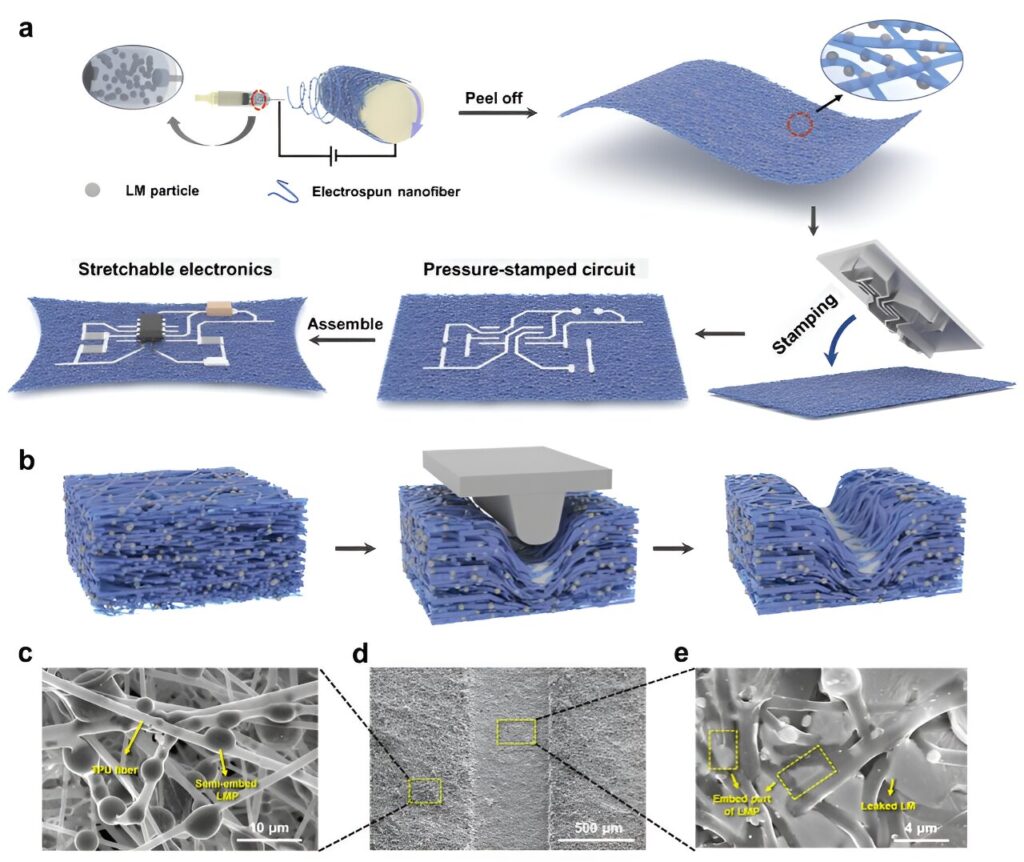In recent years, engineers and material scientists have introduced increasingly flexible electronics that could be used to create new wearable devices, such as smart watches, biosensors and health-monitoring technologies. To be safely worn by humans for prolonged periods of time, these electronics should also be permeable (i.e., letting air and humidity pass through) and bio-compatible (i.e., not harmful to the human body).
Researchers at Soochow University in China recently introduced a new methodology to fabricate liquid metal-based stretchable electronics that are stretchable, breathable and bio-compatible. Their proposed method, outlined in a paper in Nature Electronics, entails the use of circuit-patterned stamps to create multi-functional flexible electronic components for wearable devices.
“Liquid metal-based stretchable electronics have garnered substantial interest in recent times, owing to their promising prospects in the realm of wearable electronics,” Feng Yan, co-author of the paper, told Tech Xplore.
“Nevertheless, pressing challenges persist, including intricate fabrication processes encompassing etching and oxygen-plasma treatment, along with suboptimal interface interactions between liquid metal and polymeric substrates, resulting in compromised cyclic tensile stability.”
Liquid metal-based stretchable electronic materials often come with various limitations, which prevent or limit their potential for developing personalized and customized circuits. As part of their recent study, Yan and his colleagues set out to address and overcome these limitations, by introducing an alternative methodology for fabricating liquid metal-based flexible electronics.
“Our methodology involves a combination of electrostatic spinning and pressure-stamping, which bridges the technical gap between breathability, precision and processability in stretchable electronic devices,” Yan explained. “The semi-embedded liquid metal particles within nanofibers can rupture under pressure, and spill over to form continuous liquid metal regions, enabling the selective construction of conductive pathways with high circuit accuracy and outstanding stability.”
Using their newly-devised methodology, the researchers were able to rapidly prepare breathable and stretchable circuits. The fabricated circuits exhibited a high resolution (i.e., minimum linewidths of 50 µm) and a high stability, running for over 30,000 cycles under a strain of 100%.
When integrated with different electronic components, the pressure-stamped electronics created by Yan and his colleagues were found to support different functions, including square wave signal outputs, light emission and wireless charging. This means that they could be highly versatile components for wearable devices, allowing engineers to use the circuits to realize different desired capabilities.
“The remarkable biocompatibility and permeability of the circuits we created make them well-suited for collecting bioelectrical signals,” Yan said. “Furthermore, its recycling capacity and universality highlight its broad potential in the realm of flexible electronics.”
Yan and his colleagues have already used their stretchable circuits to create prototype sensors for monitoring bioelectrical signals. In the future, they could be integrated into other wearable devices for specific medical or sports-related applications.
A further advantage of the team’s flexible electronic circuits is that the liquid metal-containing membranes they are based on can easily be dismantled into individual components and recycled. This could significantly reduce their adverse impact on the environment, which could also contribute to their large-scale deployment.
“We now plan to realize the preparation of multilayer circuit boards with interlayer interconnections,” Yan added. “By precisely modulating the modulus and size of liquid metals and nanofibers, we also aspire to empower the circuits with the capability to be activated in distinct layers, tailored precisely to our evolving requirements.”
More information:
Sijie Zheng et al, Pressure-stamped stretchable electronics using a nanofibre membrane containing semi-embedded liquid metal particles, Nature Electronics (2024). DOI: 10.1038/s41928-024-01194-0
© 2024 Science X Network
Citation:
A new method to fabricate stretchable and breathable electronics (2024, July 18)
retrieved 20 July 2024
from https://techxplore.com/news/2024-07-method-fabricate-stretchable-breathable-electronics.html
This document is subject to copyright. Apart from any fair dealing for the purpose of private study or research, no
part may be reproduced without the written permission. The content is provided for information purposes only.
